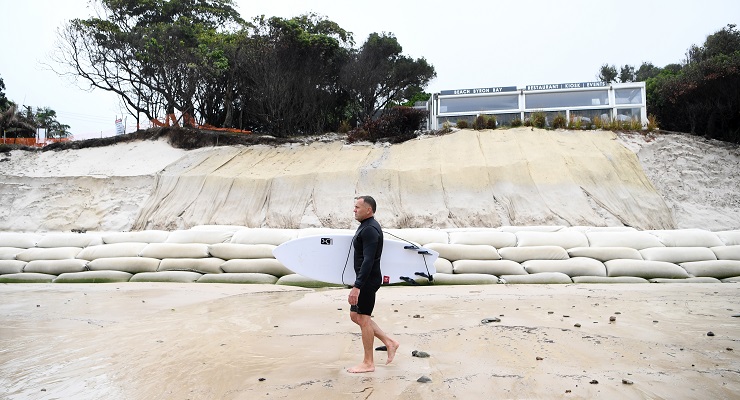
At Byron Bay, Main Beach has collapsed into the sea. Across the north coast of New South Wales, surging tides and violent storms have led to the worst coastal erosion in years. But is this a one-off freak summer of flood or the new normal? The answer is… well, kind of both.
What’s going on in Byron Bay?
The situation at Byron, and northern NSW more broadly is down to the perfect storm of both short- and long-term factors, says University of Sydney professor Andrew Short. At Byron’s Main Beach, the unique movement of sand around the headland means every few years you get a situation where there’s less sand.
“It’s a totally natural thing that’s been going on for thousands of years,” Short said.
But this year, things are worse than they’ve been for a long time. The beaches were already vulnerable because of the cyclical movement of sand before the storms hit. And the storms are worse this season because we’re in a La Niña event — which brings east coast lows, severe storms and tropical cyclones. All perfect conditions for the kind of battering that’s hitting eastern Australia right now.
Is erosion getting worse?
Anecdotally, it seems like every year more beaches are falling into the sea. There’s the “lost beach” of Stockton near Newcastle, Inverloch in Victoria, McEwans in Queensland. But we shouldn’t worry about our beaches disappearing just yet, Short says.
“We’re monitoring sites along the coasts, and if you go to most of the coast it’s in good shape,” he told Crikey.
Moreover, while climate change has intensified so many other natural processes — like the most devastating bushfire season in living memory last summer — it hasn’t had a clear impact on beach erosion so far in Australia.
“While we know sea levels are rising, we’re not as yet seeing any sea-level signal,” he said. “[But] we anticipate it will happen at some point in the future.”
According to a recent study in Nature, the world will lose half its sandy beaches by 2100.
What can we do about it?
The inevitability of beach erosion is a blessing and a curse. The good news, Short says, is there is more academic knowledge about sand movement and weather events than there’s ever been. That means state and local governments are better able to anticipate when erosion might get out of hand and prepare for it.
The bad news is there’s little we can do when faced with storms like we’re seeing in northern NSW.
“It’s very hard to stop beach erosion. You can prepare, but you try stopping those waves,” Short said.
“You can’t turn the sea back.”








The sight of beachside houses teetering at the edge of the pounding seas remind me of the Biblical parable of the foolish man who built his house upon the sand. Bearing in mind that was written c2000 years ago, you’d think it was common knowledge as well as common sense to build on firm foundations.
Really important point. The theory is that children learn from their parents’ mistakes but their own children don’t. There is some research on this which I could find if it wasn’t Xmas. It possibly explains why, 75 years after the end of WW2, we’re wall-to-wall hate-exploiting populists again.
Well thank goodness we have the option of open societal institutional frameworks of knowledges. practices & histories, and not just incestuous intergenerational family hand me down anecdotal behaviours to go by..;-)
True Joanna, but much of east coast Australia is built on sand, and not necessarily close to the beach. Raised sea levels brings into play very large parts of Sydney around Botany Bay, and low lying areas around Parramatta. Those dyke builders of Holland will have a lot of work coming their way.
As there is enough ice on the planet to raise sea level by 70 metres, and as we don’t understand the local mechanics of each melting event (we study things after they have happened), all I can say is, “You ain’t seen nothing yet”. The coastal ice barrier around Antarctica is currently beginning to break up, as predicted. This was mostly floating ice, the melting of which does not raise sea level. However, its removal clears the way for a large increase in glacier speed from the land down to the ocean, which will raise sea level. How fast? Nobody knows. In the last interglacial before this one, when the global temperature was rising much slower than we have it doing now, the maximum speed of sea level rise was one metre every 20 years, as near as I can tell from looking at the graphs showing what we think we know about that period (which is quite a lot).
I’m 72 and I live 128 metres above present sea level so why should I care? It’s because whether it happens in 100 years, or 1000 years, or even 10000 years I think it’s a horrible idea that we can be so stupid as to do it. I like beaches, coastal plains and towns and cities by the sea as they are. There’s an underwater drowned city at Alexandria in Egypt, for a glimpse at the future.
I think we should be more careful who we vote for. The definition of insanity is to keep doing what we’ve always been doing, but to expect a different outcome.
It’s unfortunate but hardly surprising that building on foredunes is a receipe for disaster, as the Gold Coast has shown many times. We learned that at university nearly 50 years ago.
A perennial problem. My memory goes back to the 60s and the cyclones at Kirra, and especially 70s when the houses in Hedges Av Mermaid Beach were threatened. Lots of digging and lots of rocks. The wealthy can afford it.
More recently the pumping from the Maroochy River to cover the natural coffee rock for the tourists to walk on etc.
Thus we have three interested parties – property owners, Councils wanting to attract tourists and finhally surfers. They may all have the same interest in maintenance of the beaches but contradictory outcomes because of their differing purposes.
Thus the apparent diversity of proposals driven by the interested parties.
As one who enjoys the water and currently retired after 60 years of surfing due to injury – OB confronts BBW. I enjoyed watching from my balcony the young surfer being delivered onto waves by a jet ski this morning – if only?
I recall Gold Coast 1974 September, they were rebuilding beaches by pumping sand (with water) after cyclone(s) had wiped out beaches previous summer; waterside property owners beware…..
G’day Maroochy, fellow surfer of only 30 years, but still going. Yes, storms of 74 and 75 winters were the biggest erosion events of lived experience. Councils also want to protect the houses for the rates. Significant council rates for houses closest to the water. I’m in one now, but well south of Gold Coast. Once they go into the sea there aren’t any rates to be had.
Come back Knut, all is forgiven.
Be sure to wear your boardies.